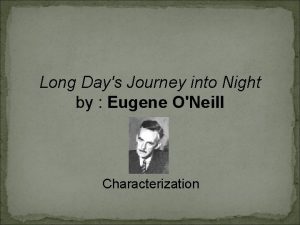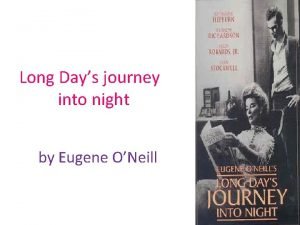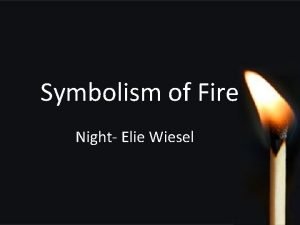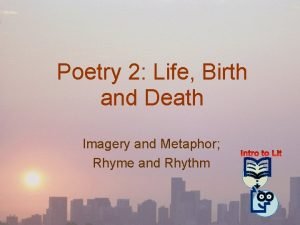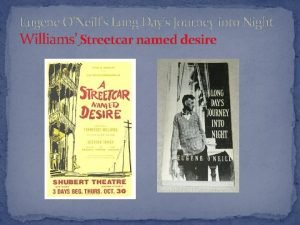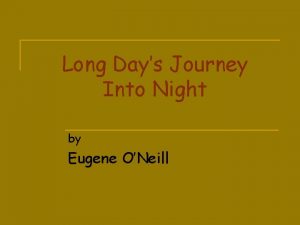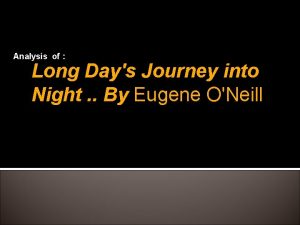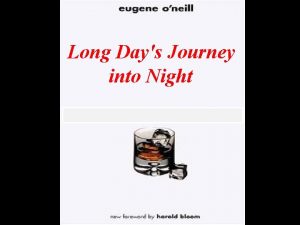LONG DAYS JOURNEY INTO NIGHT Long Days Journey










- Slides: 10

LONG DAY’S JOURNEY INTO NIGHT

Long Day’s Journey can be called O’ Neil’s creative autobiography, as it is a study, by his older self, of his “birth” as a writer amidst the painful family experiences of his youth. The play is set in 1912, the year O’ Neil left home to recover in a tuberculosis sanatorium and also began a career as a writer. His self portrayal in the play is in the form of a naïve and vulnerable Edmund Tyrone, whose illness prompts his mother’s resumption of her drug habit and also sparks a series of heartwrenching conversations between his family members. The play captures the feelings of the young O’Neill who was hurt, tormented, and wounded by his family’s arguments, accusations, and liquor and drug addiction. O’ Neil gave the script of this play to his wife on their 12 th wedding anniversary in these words, “ I give you the original script of this play of old sorrow, written in tears and blood. A sadly inappropriate gift, it would seem, for a day celebrating happiness. But you will understand. I mean it as a tribute to your love and tenderness which gave me the faith in love that enable me to face my dead at last and write this play with deep pity and understanding and forgiveness for all the four haunted Tyrones. ”

The major theme of the play is the predicament of the modern human being, who feels alone and abandoned; a stranger who never feels at home. To be a conscious being is to suffer, the play seems to suggest with its repetitive structure and tragic tone. Humans dream but are bound to fall short of their dreams, and then are haunted by the memories of their dreams. On the one hand, humans look forward to death (both literal and metaphorical) as the word “night” in the title of the play suggests because it will end the pain but on the other hand, they fear death, because it is a mystery and means the end of individuality and may be a plunge into a purposeless void.

As the play progresses it becomes obvious that something has happened in the past that haunts the Tyrones and has shaped both their individual experiences of life and their relationships to one another; something that had led them into a cycle of blame, guilt and denial. “This knowledge is communicated indirectly at first, chiefly by the discrepancy between what seem to be insignificant pleasantries and banter and the paranoid way in which the characters react during these exchanges. The clues are revealed gradually, so that it is only in act 3 that we discover with certainty what we have suspected for some time, that Mary is a dope addict. She has just resumed her habit after an abstinence of two months, a development that decimates the family’s fragile hopes and dreams. Thus, though earlier Mary complains bitterly about her loneliness and the fact that she has no friends, toward evening she welcomes the obscurity that the fog provides, cutting the Tyrones’ cottage off from the rest of the town and isolating them from curious eyes. Edmund, too, seems relieved that he can lose himself in the fog; the phrase is apt. ”

The fog in the play provides the escape that helps these characters get away from the reality. They all want to induce a state of oblivion that is ultimately destructive. None of them however, consider it destructive. James, the veteran actor, ‘can regret being seduced by fame and fortune, for instance, but he never questions the validity of his ambition itself nor recognizes the demands it has made on his family. ’ Little instances like his insistence on switching off the electric light shows a discrepancy between a seemingly objective and acceptable motivation- the need to economize and the underlying reason, the subtexts. ‘Jamie’s searching for the warm haven of happiness he left behind leads him only to Fat Violet, yet he never questions the value of the search nor seeks a suitable adult replacement for youthful innocence. Mary cannot see the destructiveness of her desire to be a nun, though this is graphically demonstrated to the audience as she rebuffs Edmund’s appeal for affection on these grounds, nor can Edmund acknowledge the death wish inherent in his desire for

The play also questions the idealism associated with motherhood. Mary, in the play, refuses to take responsibility for her actions and places blame on external circumstances. She blames her husband her sons for her own tragedy and the tragedy of the family. The men see that Mary is “aware of them merely as she is aware of other objects in the room”. She makes her sons feel unwanted. “Long Day’s Journey into Night may seem a strange starting place for a feminist analysis of modernism and post-modernism. Yet even the most conservative criticism reads this play as an enactment and embodiment of loss, specifically loss of the mother. That loss is rarely seen in the context of a more general “loss”, a cultural loss of legitimacy and authenticity, endemic in and enabling modernism, articulated as “disinheritance” by an Other “coded as feminine. ”’

The play despite only covering a period of about 16 hours and adhering to the three unities of time, place and action, takes us deep into the psyche of its characters. The play moves in retrospective, gradually revealing past guilt that has resulted in present misery while its characters are shown struggling against blinding forces represented by the fog. ‘The dramatic action confirms this, being primarily retrogressive rather than progressive. O’Neill’s characters play out their roles in the social dramas identified by Marx and the psychological dramas of Freud’s family romance. The Tyrone family are on one level case studies of the inevitable concentration of wealth in capitalism, the inevitable antagonism between brothers and between father and sons in the Oedipal family. ’

There is little dramatic action in the traditional sense. ‘Stasis and circularity are the very texture of the play. The repetition reaches an apotheosis in the final scene, for this play does not culminate in catharsis, nor even in destruction. It ends instead in a stasis which implies an inexorable continuity without change. Mary has retreated into morphine and the past. The men are no longer capable of performing what must be their most basic and instinctive act. ’ At the beginning of Act One, “sunshine comes through the windows” , but by the start of Act Four, “no light shines through the front parlor”.

In many ways the characters of the play are an amalgam of other literary characters. In fact there are many references to literature and philosophy in the play. ‘O’Neill’s characters refer, pointing away from themselves, to the poetic personae and characters of previous players, previous writers. These previous figures are imbued with the authority of a “real” existence elsewhere, off-stage, albeit in the world of books. To some extent Tyrone, Jamie and Edmund are the ghosts of Lear, Othello, Iago, Baudelaire, Swinburne, Nietzsche. The play is haunted by the past and by other men’s words, but it also haunts them. These actors inhabit a present which can only, with horrifying persistence, refer back to the past. They are indistinct, one identity merging into another. Even their paralysis seems like a convention. They are conventionally modern and hover on the brink of actions and texts where progress and redemption were possible, where character was clearly defined and active. James Tyrone haunts, is the ghostly double of, the Shakespearian heroes he once played, but which his own ‘tragic flaw’, the greed bred by insecurity, has ensured he will never play again. His sons are the ghosts of ghosts, shades generated by the Post-Romantic anti-heroes, Baudelaire, Swinburne and Nietzsche. ’ We see the sons heavily

The gaze of the characters also is important as it delves them into a feeling of being scrutinized. In a larger context‘ the interaction of gazes in Long Day’s Journey mitigates the onstage confinement; as Foucault and Mary both predicted, the gaze of an audience at a play offers resistance to rigid control. Indeed, such a gaze does more, for power does more than repress. “Power produces, ” Foucault argues; “it produces reality; it produces domains of objects and rituals of truth”; it produces “[t]he individual and the knowledge that may be gained of him. ” While the claim is broad, it points to a final connection between panopticism and Journey. The efficiency of the Panopticon is linked to the way it provides “a machine for dissociating the see/being seen dyed, ” a machine which “automatizes and disindividualizes power” by locating it “not so much in a person as in a certain concerted distribution of bodies, surfaces, lights, gazes. ”The theater, of course, also produces knowledge by distributing bodies, surfaces, lights, and gazes; note how Foucault’s imagery almost parallels O’Neill’s account of the machinery which produced “Like. . . So Many Small Theatres” of Monte Cristo’s escape. Hence when O’Neill invokes theater’s machinery to rearrange the panoptic gaze—when he introduces a new axis of seeing/being seen which integrates rather than isolates Mary— he moves the production of identity along this axis into the
 Long day's journey into night dramatist
Long day's journey into night dramatist Long day's journey into night
Long day's journey into night Tall+short h
Tall+short h Once upon a time a little man
Once upon a time a little man Elie wiesel night symbols
Elie wiesel night symbols Silent night holy night all is calm
Silent night holy night all is calm Do not go gentle into that good night meter
Do not go gentle into that good night meter Youtube do not go gentle into that good night
Youtube do not go gentle into that good night Do not go gentle into that good night personification
Do not go gentle into that good night personification Because i could not stop for death imagery
Because i could not stop for death imagery Do not go gentle into that good night metaphors
Do not go gentle into that good night metaphors
